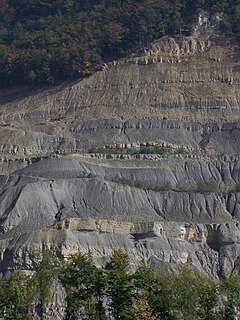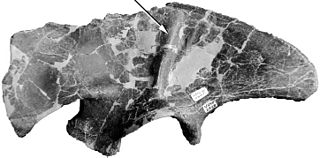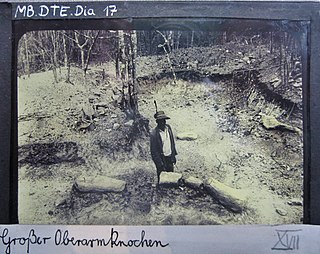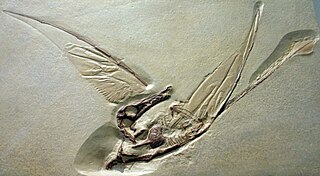The Jurassic is a geologic period and system that spanned 56 million years from the end of the Triassic Period 201.3 million years ago (Mya) to the beginning of the Cretaceous Period 145 Mya. The Jurassic constitutes the middle period of the Mesozoic Era. The Jurassic is named after the Jura Mountains in the European Alps, where limestone strata from the period were first identified.

The Bibionomorpha are an infraorder of the suborder Nematocera. One of its constituent families, the Anisopodidae, is the presumed sister taxon to the entire suborder Brachycera. Several of the remaining families in the infraorder are former subfamilies of the Mycetophilidae, which has been recently subdivided. The family Axymyiidae has recently been removed from the Bibionomorpha to its own infraorder Axymyiomorpha.

The Morrison Formation is a distinctive sequence of Upper Jurassic sedimentary rock found in the western United States which has been the most fertile source of dinosaur fossils in North America. It is composed of mudstone, sandstone, siltstone, and limestone and is light gray, greenish gray, or red. Most of the fossils occur in the green siltstone beds and lower sandstones, relics of the rivers and floodplains of the Jurassic period.

Torvosaurus is a genus of carnivorous megalosaurid theropod dinosaur that lived approximately 165 to 148 million years ago during the late Middle and Late Jurassic period in what is now Colorado, Portugal, and Germany. It contains two currently recognized species, Torvosaurus tanneri and Torvosaurus gurneyi.

Barosaurus was a giant, long-tailed, long-necked, plant-eating dinosaur closely related to the more familiar Diplodocus. Remains have been found in the Morrison Formation from the Upper Jurassic Period of Utah and South Dakota. It is present in stratigraphic zones 2-5.
In the geological timescale, the Tithonian is the latest age of the Late Jurassic epoch or the uppermost stage of the Upper Jurassic series. It spans the time between 152.1 ± 4 Ma and 145.0 ± 4 Ma. It is preceded by the Kimmeridgian and followed by the Berriasian stage.

The Oxfordian is, in the ICS' geologic timescale, the earliest age of the Late Jurassic epoch, or the lowest stage of the Upper Jurassic series. It spans the time between 163.5 ± 4 Ma and 157.3 ± 4 Ma. The Oxfordian is preceded by the Callovian and is followed by the Kimmeridgian.

Stokesosaurus is a genus of small, carnivorous early tyrannosauroid theropod dinosaurs from the late Jurassic period of Utah, United States.

Termatosaurus is a genus of archosaur known from several specimens spanning two species. Its remains come from the Upper Triassic and was once thought to have survived until the Early Jurassic, but the Jurassic remains were redescribed as plesiosaur remains. It has only been found in France, England, Germany and Switzerland. and two species are known of this animal: the type species, Termatosaurus albertii, named by Meyer and T. Plieninger in 1844; and T. crocodilinus, by Quenstedt (1858). It is very obscure and apparently considered to be dubious.

Ohmdenosaurus is a genus of herbivorous dinosaur from the Lower or Middle Toarcian age of the Early Jurassic in what is now Ohmden, Germany. It is one of the earliest European sauropods. It is also one of the few sauropods described from the Toarcian of the modern Northern Hemisphere, along with Tazoudasaurus, which may be a relative. Ohmdenosaurus lived on an island series in what is now the region of Black Forest High and the Vosges Massif. Alternatively, the genus may have come from Bohemia. Its fossils were originally described as plesiosaur remains, until a revision of the holotype in 1978 identified them as sauropod fossils. It is the only dinosaur identified from the Posidonia Shale.
Lisboasaurus is a small genus of Mesozoic crocodylomorph that lived in fresh water. It is known from fossilized tooth and jaw fragments of Late Jurassic and Early Cretaceous age. Two species have been described. In the past Lisboasaurus has been interpreted as an avialan, troodontid, or an anguimorph lizard. Both species are currently assigned to Crocodylomorpha, one is reassigned to the genus Lusitanisuchus.

Sphenosuchia is a suborder of basal crocodylomorphs that first appeared in the Triassic and occurred into the Middle Jurassic. Most were small, gracile animals with an erect limb posture. They are now thought to be ancestral to crocodyliforms, a group which includes all living crocodilians.

The Tendaguru Formation, or Tendaguru Beds are a highly fossiliferous formation and Lagerstätte in southeastern Tanzania. The formation represents the oldest sedimentary unit of the Mandawa Basin, overlying Neoproterozoic basement, separating by a long hiatus and unconformity. The formation reaches a total sedimentary thickness of more than 110 metres (360 ft). The formation ranges in age from the late Middle Jurassic to the early Early Cretaceous, Oxfordian to Hauterivian stages, with the base of the formation possibly extending into the Callovian.

The Fernie Formation is a stratigraphic unit of Jurassic age. It is present in the western part of the Western Canada Sedimentary Basin in western Alberta and northeastern British Columbia. It takes its name from the town of Fernie, British Columbia, and was first defined by W.W. Leach in 1914.
Lusitanisuchus is an extinct genus of mesoeucrocodylian crocodylomorph. Mostly fragmentary fossils have been found from several localities in Portugal and are Late Jurassic and Early Cretaceous in age.

Spinophorosaurus is a genus of sauropod dinosaur that lived in what is now Niger during the Middle Jurassic period. The first two specimens were excavated in the 2000s by German and Spanish teams under difficult conditions. The skeletons were brought to Europe and digitally replicated, making Spinophorosaurus the first sauropod to have its skeleton 3D printed, and were to be returned to Niger in the future. Together, the two specimens represented most of the skeleton of the genus, and one of the most completely known basal sauropods of its time and place. The first skeleton was made the holotype specimen of the new genus and species Spinophorosaurus nigerensis in 2009; the generic name refers to what was initially thought to be spiked osteoderms, and the specific name refers to where it was found. A juvenile sauropod from the same area was later assigned to the genus.

Rhamphorhynchidae is a group of early "rhamphorhynchoid" pterosaurs named after Rhamphorhynchus, that lived in the Late Jurassic. The family Rhamphorhynchidae was named in 1870 by Harry Govier Seeley.

Aerodactylus is a pterosaur genus containing a single species, Aerodactylus scolopaciceps, previously regarded as a species of Pterodactylus.
Wamweracaudia is a large herbivorous sauropod dinosaur from the Late Jurassic Tendaguru Formation of Tanzania, Africa, 155-145 million years ago.

The Ciechocinek Formation is a Jurassic geologic formation which extends across the Baltic coast from Grimmen, Germany, to Nida, Lithuania, with its major sequence in Poland and boreholes in Kaliningrad. Dinosaur species uncovered here include the Thyreorporan Emausaurus and others with an unclassified genus.














